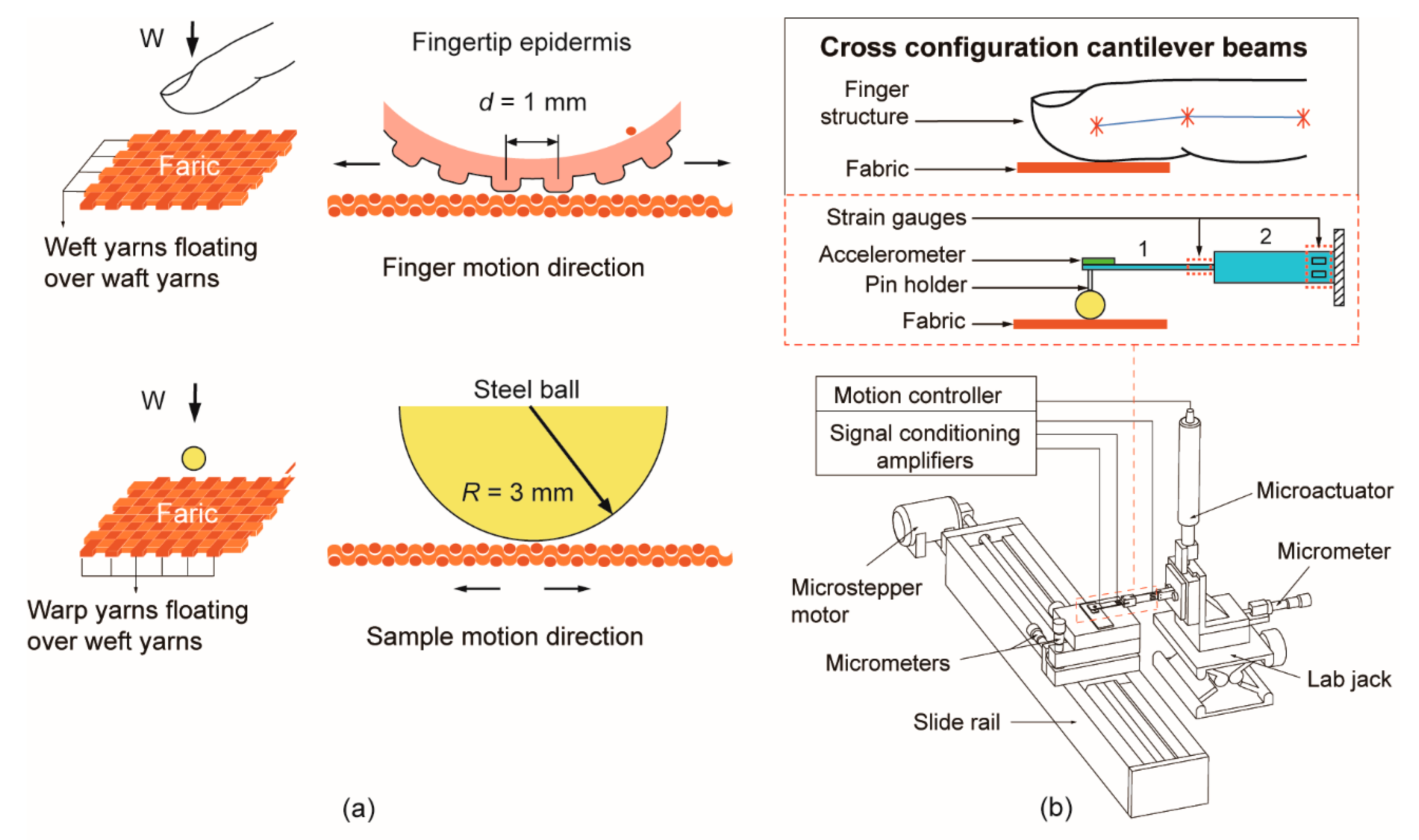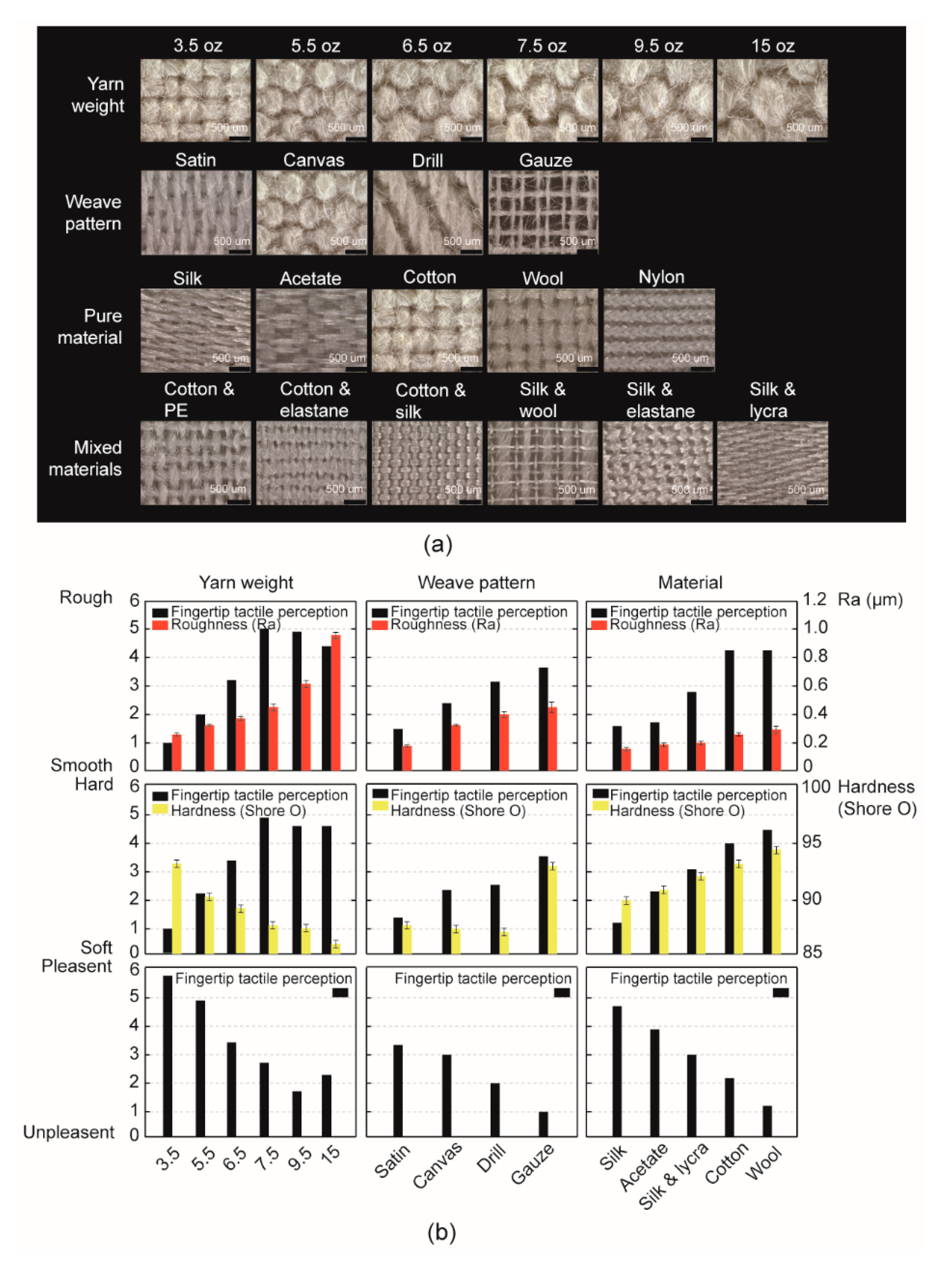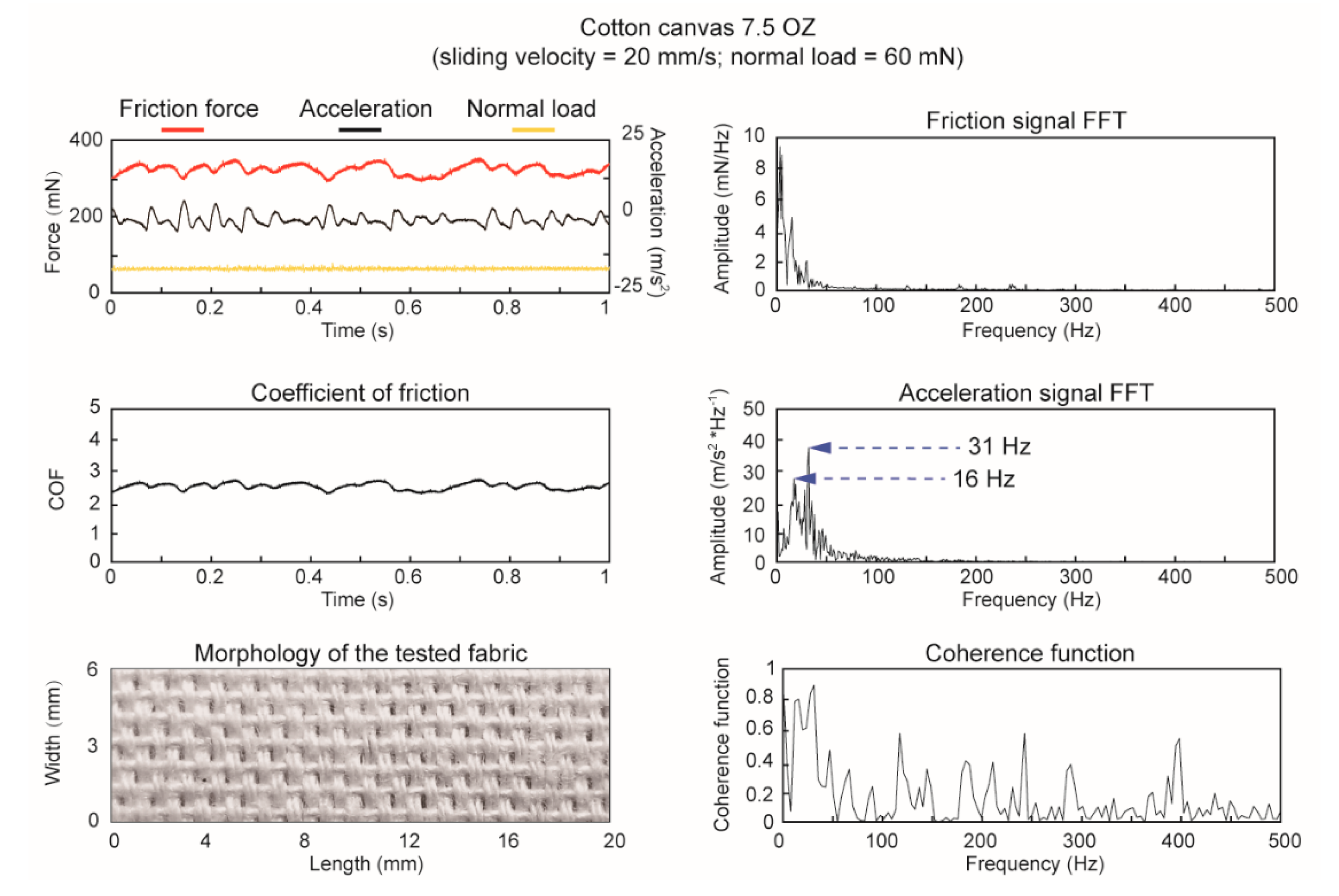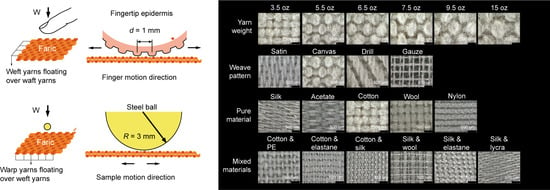Humanoid Identification of Fabric Material Properties by Vibration Spectrum Analysis
Abstract
:1. Introduction
2. Experimental and Method
2.1. Fabrics Samples
2.2. Participants
2.3. Experimental Sprocedure and Method
3. Results and Discussions
3.1. Fingertip Sensation Test of Fabric Textures
3.2. Signals on Fabric Textures Obtained by the Tactile Sensor
3.3. Yarn Weight Tactile Perception
3.4. Weave Pattern Tactile Perception
3.5. Fabric Material Tactile Perception
4. Conclusions
Supplementary Materials
Author Contributions
Funding
Acknowledgments
Conflicts of Interest
References
- Lederman, S.J.; Klatzky, R.L. Hand movements: A window into haptic object recognition. Cogn. Psychol. 1987, 19, 342–368. [Google Scholar] [CrossRef]
- Huang, G.; Metaxas, D.; Govindaraj, M. Feel the Fabric: An Audio-Haptic Interface. In Proceedings of the 2003 ACM SIGGRAPH/Eurographics Symposium on Computer Animation, San Diego, CA, USA, 26–27 July 2003; Eurographics Association: Aire-la-Ville, Switzerland, 2003. [Google Scholar]
- Loewenstein, W.R. Mechano-electric transduction in the pacinian corpuscle. Initiation of sensory impulses in mechanoreceptors. In Principles of Receptor Physiology; Springer: Berlin/Heidelberg, Germany, 1971; Volume 1, pp. 269–290. [Google Scholar]
- Mountcastle, V.B.; Lamotte, R.H.; Carli, G. Detection thresholds for stimuli in humans and monkeys: Comparison with threshold events in mechanoreceptive afferent nerve fibers innervating the monkey hand. J. Neurophysiol. 1972, 35, 122–136. [Google Scholar] [CrossRef] [PubMed]
- Bensmaïa, S.; Hollins, M. Pacinian representations of fine surface texture. Percept. Psychophys. 2005, 67, 842–854. [Google Scholar] [CrossRef] [PubMed]
- Gerhardt, L.C.; Mattle, N.; Schrade, G.U.; Spencer, N.D.; Derler, S. Study of skin-fabric interactions of relevance to decubitus: Friction and contact-pressure measurements. Skin Res. Technol. 2008, 14, 77–88. [Google Scholar] [CrossRef] [PubMed]
- Johnson, K.O. Neural mechanisms of tactual form and texture discrimination. Fed. Proc. 1983, 42, 2542–2547. [Google Scholar] [PubMed]
- Vega-Bermudez, F.; Johnson, K.O. SA1 and RA receptive fields, response variability, and population responses mapped with a probe array. J. Neurophysiol. 1999, 81, 2701–2710. [Google Scholar] [CrossRef] [PubMed]
- Johnson, K.O.; Yoshioka, T.; Vega-Bermudez, F. Tactile functions of mechanoreceptive afferents innervating the hand. J. Clin. Neurophysiol. 2000, 17, 539–558. [Google Scholar] [CrossRef] [PubMed]
- Johnson, K.O. The roles and functions of cutaneous mechanoreceptors. Curr. Opin. Neurobiol. 2001, 11, 455–461. [Google Scholar] [CrossRef]
- Park, J.; Kim, M.; Lee, Y.; Lee, H.S.; Ko, H. Fingertip skin–inspired microstructured ferroelectric skins discriminate static/dynamic pressure and temperature stimuli. Sci. Adv. 2015, 1, e1500661. [Google Scholar] [CrossRef] [PubMed]
- Ding, S.; Bhushan, B. Tactile perception of skin and skin cream by friction induced vibrations. J. Colloid Interface Sci. 2016, 481, 131–143. [Google Scholar] [CrossRef] [PubMed]
- Hertenstein, M.J.; Weiss, S.J. The Handbook of Touch: Neuroscience, Behavioral, and Health Perspectives; Springer: Berlin, Germany, 2011. [Google Scholar]
- Ding, S.; Pan, Y.; Tong, M.; Zhao, X. Tactile perception of roughness and hardness to discriminate materials by friction-induced vibration. Sensors 2017, 17, 2748. [Google Scholar] [CrossRef] [PubMed]
- Holliins, M.; Faldowski, R.; Rao, S.; Young, F. Perceptual dimensions of tactile surface texture: A multidimensional scaling analysis. Percept. Psychophys. 1993, 54, 697–705. [Google Scholar] [CrossRef] [Green Version]
- Ramalho, A.; Szekeres, P.; Fernandes, E. Friction and tactile perception of textile fabrics. Tribol. Int. 2013, 63, 29–33. [Google Scholar] [CrossRef]
- Fishel, J.A.; Loeb, G.E. Bayesian exploration for intelligent identification of textures. Front. Neurorobot. 2012, 6, 4. [Google Scholar] [CrossRef] [PubMed]
- Tiest, W.M.B.; Kappers, A.M.L. Analysis of haptic perception of materials by multidimensional scaling and physical measurements of roughness and compressibility. Acta Psychol. 2006, 121, 1–20. [Google Scholar] [CrossRef] [PubMed]
- Wandersman, E.; Candelier, R.; Debrégeas, G.; Prevost, A. Texture-induced modulations of friction force: The fingerprint effect. Phys. Rev. Lett. 2011, 107, 164301. [Google Scholar] [CrossRef] [PubMed]
- Bueno, M.A.; Lemaire-Semail, B.; Amberg, M.; Giraud, F. A simulation from a tactile device to render the touch of textile fabrics: A preliminary study on velvet. Text. Res. J. 2014, 84, 1428–1440. [Google Scholar] [CrossRef]
- Zhang, M.; Mak, A.F.T. In vivo friction properties of human skin. Prosthet. Orthot. Int. 1999, 23, 135–141. [Google Scholar] [PubMed]
- Tiest, W.M.B.; Kappers, A.M.L. Haptic and visual perception of roughness. Acta Psychol. 2007, 124, 177–189. [Google Scholar] [CrossRef] [PubMed]
- Whitaker, T.A.; Simoes, F.C.; Newell, F.N. Vision and touch: Independent or integrated systems for the perception of texture? Brain Res. 2009, 1242, 59–72. [Google Scholar] [CrossRef] [PubMed]
- Overvliet, K.E.; Karana, E.; Soto-Faraco, S. Perception of naturalness in textiles. Mater. Des. 2016, 90, 1192–1199. [Google Scholar] [CrossRef] [Green Version]
- Solaymani, S.; Elahi, S.M.; Nezafat, N.B.; Zahrabi, H.; Boochani, A.; Naseri, M. Characterization of microroughness parameters in Cu-C nanocomposite prepared by co-deposition of RF-sputtering and RF-PECVD. Eur. Phys. J. Appl. Phys. 2013, 64, 11301. [Google Scholar] [CrossRef]
- Bolanowski, S.J., Jr.; Gescheider, G.A.; Verrillo, R.T.; Checkosky, C.M. Four channels mediate the mechanical aspects of touch. J. Acoust. Soc. Am. 1998, 84, 1680–1694. [Google Scholar] [CrossRef]
- Fazekas, Z.; Komuves, J.; Renyi, I.; Surjan, L. Towards Objective Visual Assessment of Fabric Features. In Proceedings of the Seventh International Conference on Image Processing and ITS Applications 1999, Manchester, UK, 13–15 July 1999; Volume 1, pp. 411–416. [Google Scholar]
- Cardamone, J.M.; Damert, W.C.; Phillips, J.G.; Marmer, W.N. Digital image analysis for fabric assessment. Text. Res. J. 2002, 72, 906–916. [Google Scholar] [CrossRef]
- Strese, H.; Kuck, M.; Benken, R.; Schanzer, S.; Richter, H.; Fluhr, J.W.; Meinke, M.C.; Sterry, W.; Lademann, J.M.; Benderoth, C.; et al. Application of optical methods to characterize textile materials and their influence on the human skin. J. Biomed. Opt. 2011, 16, 046013. [Google Scholar] [CrossRef] [PubMed]
- Bensaid, S.; Osselin, J.F.; Schacher, L.; Adolphe, D. The effect of pattern construction on the tactile feeling evaluated through sensory analysis. J. Text. Inst. 2006, 97, 137–145. [Google Scholar] [CrossRef]
- Hu, H.; Han, Y.; Song, A.; Chen, S.; Wang, C.; Wang, Z. A finger-shaped tactile sensor for fabric surfaces evaluation by 2-dimensional active sliding touch. Sensors 2014, 14, 4899–4913. [Google Scholar] [CrossRef] [PubMed]
- Koç, İ.M.; Aksu, C. Tactile sensing of constructional differences in fabrics with a polymeric fingertip. Tribol. Int. 2013, 59, 339–349. [Google Scholar] [CrossRef]
- Kikuuwe, R.; Nakamura, K.; Yamamoto, M. Finger-mounted tactile sensor for evaluating surfaces. Trans. Jpn. Soc. Mech. Eng. 2012, 77, 4567–4580. [Google Scholar] [CrossRef]
- Chen, S.; Ge, S.; Tang, W.; Zhang, J.; Chen, N. Tactile perception of fabrics with an artificial finger compared to human sensing. Text. Res. J. 2015, 85, 2177–2187. [Google Scholar] [CrossRef]
- Hollins, M.; Risner, S.R. Evidence for the duplex theory of tactile texture perception. Percept. Psychophys. 2000, 62, 695–705. [Google Scholar] [CrossRef] [PubMed] [Green Version]
- Naylor, G.R.S.; Stanton, J.H.; Speijers, J. Skin comfort of base layer wool garments. Part 2: Fiber diameter effects on fabric and garment prickle. Text. Res. J. 2014, 84, 1506–1514. [Google Scholar] [CrossRef]
- Hivet, G.; Allaoui, S.; Cam, B.T.; Ouagne, P.; Soulat, D. Design and potentiality of an apparatus for measuring yarn/yarn and fabric/fabric friction. Exp. Mech. 2012, 52, 1123–1136. [Google Scholar] [CrossRef]
- Ramalho, A.; Silva, C.L.; Pais, A.A.C.C.; Sousa, J.J.S. In vivo friction study of human skin: Influence of moisturizers on different anatomical sites. Wear 2007, 263, 1044–1049. [Google Scholar] [CrossRef] [Green Version]
- Bertaux, E.; Lewandowski, M.; Derler, S. Relationship between friction and tactile properties for woven and knitted fabrics. Text. Res. J. 2007, 77, 387–396. [Google Scholar] [CrossRef]
- Yenket, R.; Edgar Chambers, I.V.; Gatewood, B.M. Color has little effect on perception of fabric handfeel tactile properties in cotton fabrics. J. Sens. Stud. 2007, 22, 336–352. [Google Scholar] [CrossRef]
- Paillermattei, C.; Nicoli, S.; Pirot, F.; Vargiolu, R.; Zahouani, H. A new approach to describe the skin surface physical properties in vivo. Colloids Surf. B Biointerfaces 2009, 68, 200–206. [Google Scholar] [CrossRef] [PubMed]
- Bhushan, B. Introduction to Tribology, 2nd ed.; Wiley: New York, NY, USA, 2013; 214p. [Google Scholar]







| Name | Yarn Weight of Cotton Canvas (oz/yd2) | Weaves | ||||||||
|---|---|---|---|---|---|---|---|---|---|---|
| 3.5 | 5.5 | 6.5 | 7.5 | 9.5 | 15 | Gauze | Drill | Canvas | Satin | |
| Ra (µm) | 0.225 | 0.348 | 0.382 | 0.461 | 0.622 | 0.951 | 0.436 | 0.401 | 0.348 | 0.132 |
| Hardness (Shore o) | 92.0 | 90.5 | 89.0 | 8.0 | 87.5 | 85.0 | 93.0 | 87.0 | 87.5 | 88.0 |
| kv | 366 | 503 | 620 | 718 | 1028 | 1732 | 728 | 633 | 503 | 64 |
| kw | 2.67 | 4.15 | 5.13 | 7.86 | 9.81 | 20.1 | 12.1 | 9.11 | 4.15 | 2.08 |
| Name | Pure Materials | Mixed Materials | |||||||||
|---|---|---|---|---|---|---|---|---|---|---|---|
| Silk | Acetate | Cotton | Wool | Nylon | Cotton and Polyethylene | Cotton and Elastane | Cotton and Silk | Silk and Lycra | Silk and Elastane | Silk and Wool | |
| Ra (µm) | 0.179 | 0.194 | 0.286 | 0.310 | 0.042 | 0.227 | 0.201 | 0.174 | 0.104 | 0.038 | 0.431 |
| Hardness (Shore o) | 90.5 | 91.0 | 93.5 | 94.0 | 88.5 | 91.5 | 90.5 | 92 | 91.5 | 89 | 95 |
| kv | 140 | 161 | 366 | 385 | 39.1 | 299 | 163 | 143 | 88 | 30.1 | 618 |
| kw | 1.16 | 1.43 | 2.67 | 3.58 | 0.631 | 1.71 | 1.10 | 1.95 | 1.71 | 0.708 | 8.30 |
© 2018 by the authors. Licensee MDPI, Basel, Switzerland. This article is an open access article distributed under the terms and conditions of the Creative Commons Attribution (CC BY) license (http://creativecommons.org/licenses/by/4.0/).
Share and Cite
Ding, S.; Pan, Y.; Zhao, X. Humanoid Identification of Fabric Material Properties by Vibration Spectrum Analysis. Sensors 2018, 18, 1820. https://doi.org/10.3390/s18061820
Ding S, Pan Y, Zhao X. Humanoid Identification of Fabric Material Properties by Vibration Spectrum Analysis. Sensors. 2018; 18(6):1820. https://doi.org/10.3390/s18061820
Chicago/Turabian StyleDing, Shuyang, Yunlu Pan, and Xuezeng Zhao. 2018. "Humanoid Identification of Fabric Material Properties by Vibration Spectrum Analysis" Sensors 18, no. 6: 1820. https://doi.org/10.3390/s18061820






